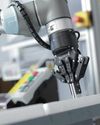The Rise of Killer Bots
Innovation & Tech Today
|Volume 9 / Issue 1
The Deployment of Weaponized Robots on Our Streets and Foreign Battlefields is Offering a Chilling Glimpse Into the Future of Policing and Warfare.

With the passage by San Francisco’s board of supervisors of an ordinance authorizing their use, killer robots have sparked an overdue national conversation. And while that ordinance may have seemed uncharacteristic for Baghdad by the Bay, there are broader implications to opening this particular Pandora’s box. So thorny are the issues, in fact, that San Francisco quickly revoked the ordinance amid howls of protest from citizens and civil libertarians.
The Dallas Police Department pioneered law enforcement’s use of killer robots when, in 2016, they deployed a bomb disposal robot to deliver a lethal explosive to a barricaded sniper who had murdered five police officers. At the time, it was an improvised response when necessity was the mother of invention, but other police agencies took notice and prepared for their own use of deadly force by human-controlled robots.
The use of killer robots would come as little surprise to the U.S. Air Force and Navy who began using radio-controlled Flying Fortresses & Liberators in World War II. These unmanned bombers were packed with explosives to be used, kamikaze-style, against hardened German U2 missile batteries. Those operations resulted in little success and killed many takeoff pilots, including Joseph P. Kennedy, Jr., ( JFK’s older brother) when his plane exploded prematurely before he could bail out over England.
Killer Bots in the Modern Age
Cette histoire est tirée de l'édition Volume 9 / Issue 1 de Innovation & Tech Today.
Abonnez-vous à Magzter GOLD pour accéder à des milliers d'histoires premium sélectionnées et à plus de 9 000 magazines et journaux.
Déjà abonné ? Se connecter
PLUS D'HISTOIRES DE Innovation & Tech Today

Innovation & Tech Today
Acting and AI
Hollywood Legend William H. Macy on the Challenges of Quickly-Changing Technology
15 mins
Volume 9 / Issue 4

Innovation & Tech Today
New Mexico: A Rising Tech Hub
Explosive Growth Driven by Strategic Investments and Innovation
2 mins
Volume 9 / Issue 4

Innovation & Tech Today
Robots and Space Exploration
From Mars Rovers to Beyond
3 mins
Volume 9 / Issue 4

Innovation & Tech Today
Charting New Territories
The Beginning of Robotization with Cobots
2 mins
Volume 9 / Issue 4

Innovation & Tech Today
AI and Design
Is The Art World Embracing Al?
3 mins
Volume 9 / Issue 4

Innovation & Tech Today
Behind the Scenes of the Netflix Film Spaceman
Exclusive Interview with Director John Renck
4 mins
Volume 9 / Issue 4

Innovation & Tech Today
Autonomous Robotics
Are Delivery Bots Getting Bigger?
2 mins
Volume 9 / Issue 4

Innovation & Tech Today
A World of Limitless Innovations
The Next Big Things In Consumer Tech—Direct From McHenry, Illinois
4 mins
Volume 9 / Issue 4

Innovation & Tech Today
The Rise of Smart Home Furniture
Merging Comfort With Technology Like Never Before
2 mins
Volume 9 / Issue 4

Innovation & Tech Today
The Next Generation of Smart Homes
A Glimpse into the Future of Residential Tech
4 mins
Volume 9 / Issue 4
Translate
Change font size

